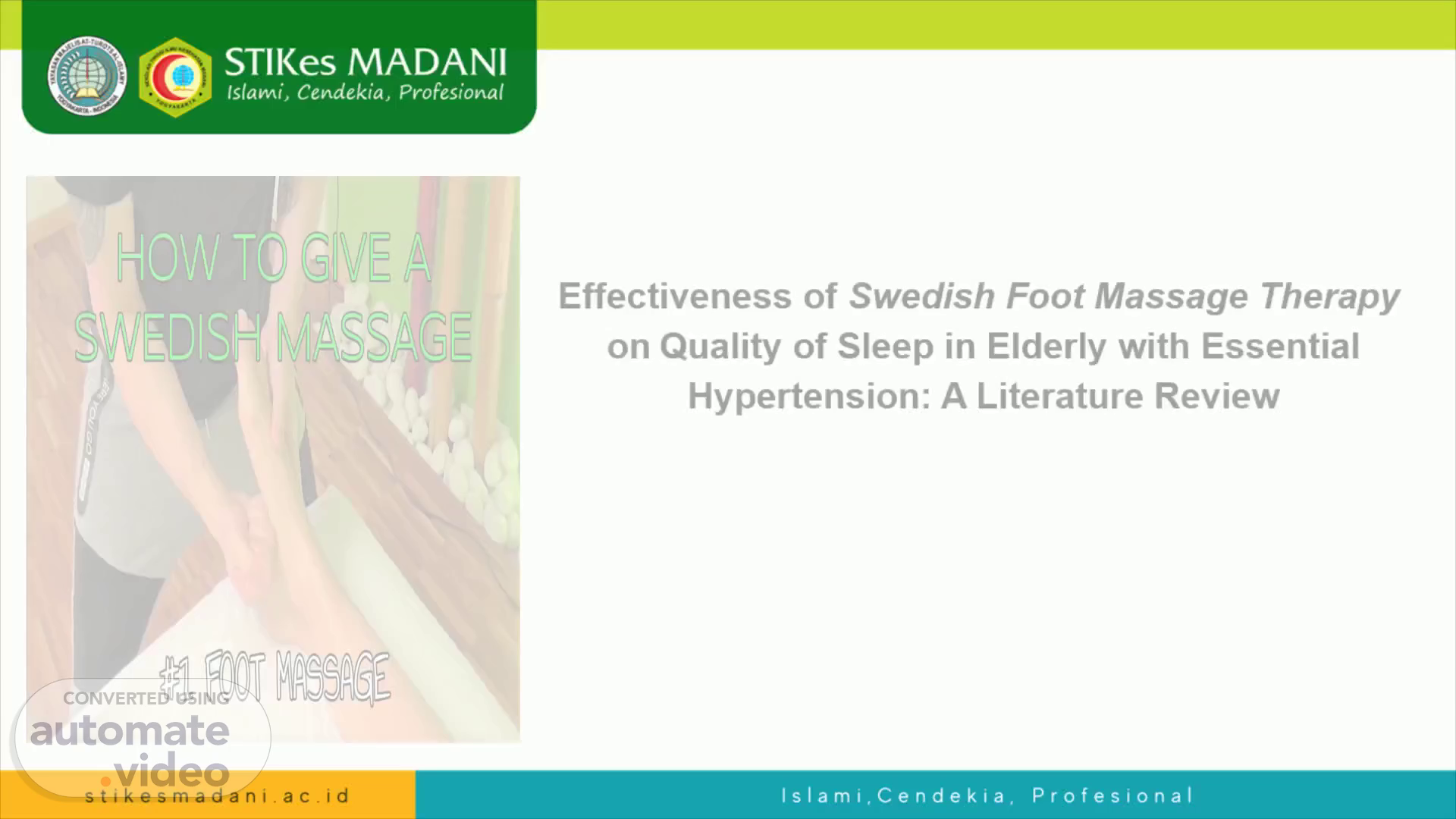
Effectiveness of Swedish Foot Massage Therapy on Quality of Sleep in Elderly with Essential Hypertension: A Literature Review
Scene 1 (0s)
Effectiveness of Swedish Foot Massage Therapy on Quality of Sleep in Elderly with Essential Hypertension: A Literature Review.
Scene 2 (35s)
Background. Aging processes in the elderly lead to degenerative diseases, one of them being essential hypertension. The elderly with hypertension often complain about sleeping problems, difficulty staying awake, often waking up in the middle of the night, and later difficulty going back to sleep, waking up too early, and sleeping poorly. Treatment of sleeping problems may include pharmacology and non-pharmacology. One nonpharmacological treatment was a complementary therapy called foot massage with Swedish techniques. Swedish massage technique consists of a combination of five basic movements, namely: effleurage, petrissage, tapotement, friction and vibration. While foot massage is massage therapy and reflexology on the feet..
Scene 3 (1m 49s)
METHODS. Framework The PICO framework was used to search for articles Keyword The keywords used in this study were “Swedish foot massage” AND “sleep quality” AND “hypertension”. Databased Five databases: Science Direct, Springer Nature, Hindawi , Research gate, and sinta Population/problem: Elderly with essential hypertension, Intervention: Swedish foot massage, Comparation: No comparison of interventions, and Outcome: Sleep quality..
Scene 4 (3m 5s)
The literature selection process.
Scene 5 (5m 10s)
RESULTS AND DISCUSSION. All journals that are the samples of this study are experimental research. The research design used was quasi experiment, clinical trial, randomized controlled study. The sample selection method is purposive sampling, total sampling, random sampling, and randomized control trial. The population used in these 5 research journals includes patients in hospitals, social protection centers , posyandu and health centers . The total number of respondents used in each study is in the range of 8-90 people..
Scene 6 (6m 2s)
RESULTS AND DISCUSSION. The tools used in the intervention were a sphygmomanometer to measure blood pressure and the Pittsburgh Sleep Quality Index (PSQI) questionnaire, Richard Campbell Sleep Quationare (RCSQ), and St. Mary's Hospital Sleep Questionnaire (SMHSQ). In the 5 research journals analyzed , the majority of research interventions were provided by competent and trained people. The duration of the research intervention varies widely, ranging from 2 days to 1 month. The average frequency of an intervention is 1-2 times a day. The duration of each meeting ranges from 20-40 minutes..
Scene 7 (7m 21s)
RESULTS AND DISCUSSION. Massage is a non-pharmacological treatment effort by applying pressure or massaging the body tissues. The effect of foot massage on blood pressure is to stimulate pressure receptors under the skin, increase vagal activity, and reduce cortisol, causing many effects including lowering blood pressure. F oot massage responds to foot nerve sensors which then massage this foot increases serotonin and dopamine neurotransmitters whose stimulation is transmitted to the hypothalamus and produces Corticotropin Releasing Factor (CRF) which stimulates the pituitary gland to increase the production of Proopioid melanocortin (POMC) and stimulates the adrenal medulla to increase the secretion of endorphins that activate the parasympathetic and than occurs vasodilation blood vessels. Facilitates blood flow thereby helping tense muscles to relax so that the RAS is stimulated to release serotonin and help stimulate sleep and improve sleep quality..
Scene 8 (8m 51s)
CONCLUSION. Based on the results of the analysis of 5 research journals, it is recommended that the intervention of Swedish foot massage therapy to treat sleep disorders in patients with hypertension is recommended to be applied by the community and health workers. This intervention has several advantages, namely non-pharmacological methods in the form of complementary therapies that can be done independently at home, do not cost money, are short, safe, and effective in improving sleep quality in hypertensive patients ..
Scene 9 (9m 36s)
THANK YOU FOR YOUR ATTENTION Jazakumullahu khairan.